Access Agilent eNewsletter April 2016
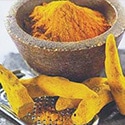
Fast, economical assessment of herbals with Agilent 1290 Infinity LC system and LC columns
John Lee, Agilent Food Market Manager
The global market for herbal remedies is experiencing tremendous growth driven by the increasing acceptance of preventive care as a safe, effective way to maintain good health. The global herbal supplements and remedies market is expected to grow to $115 billion by 2020[1].
This growth creates a need for suppliers and distributors to expeditiously meet expectations for quantity, quality, authenticity, freshness, and source. In turn, these expectations have placed pressure on diagnostic labs to handle increased demand for rapid, accurate, and economical testing of herbals. Examples of popular herbals include saffron extract, true cinnamon, turmeric, and ginkgo biloba.
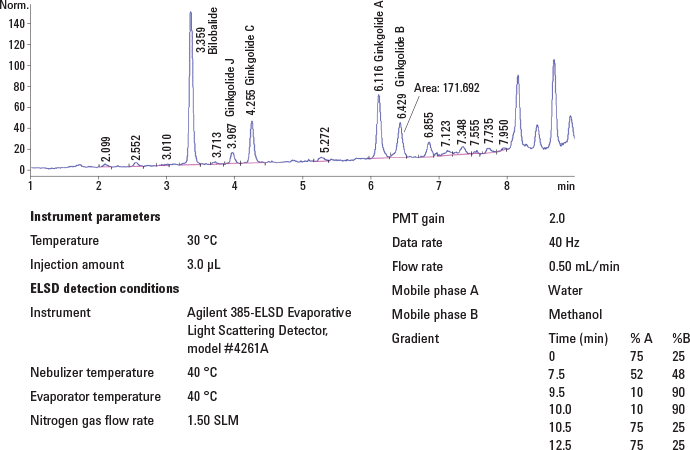
Figure 1. Terpene lactones in ginkgo biloba extract. Agilent 1290 Infinity LC with an Agilent Poroshell 120 SB-C18 2.7 µm column.
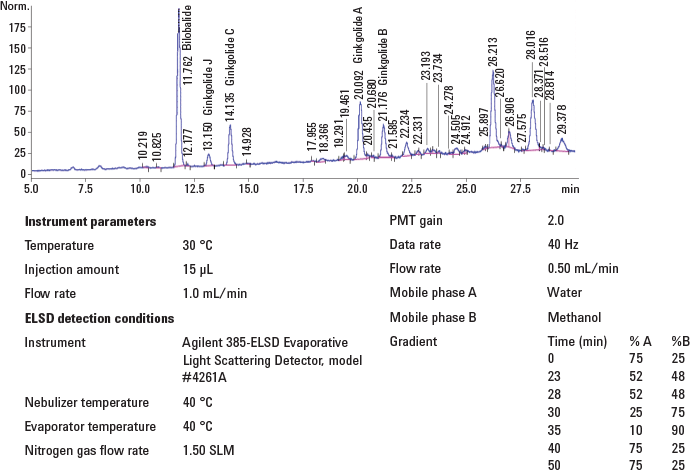
Figure 2. Terpene lactones in ginkgo biloba extract. USP method using Phenomenex Luna C-18 250 x 4.6 mm, 5.0 µm column.
Herbals are complex and require high selectivity
Extracts from herbals are complex and there is a need for high selectivity. Gradient liquid chromatography is a common method for assessment. Reference methods often have long run times, but the use of the Agilent 1290 Infinity LC coupled with new column technologies has been found to not only produce faster run times, but reduce solvent consumption, as well.
Quicker analysis and significant solvent savings
One busy lab decided to test this Agilent solution against their USP method for analysis of terpene lactones in ginkgo biloba with dramatic results[2]. The chromatogram in Figure 1 shows a run time that was four times less than the USP method. Additionally, this solution delivered an eightfold solvent savings versus the existing analysis method.
Figure 2 illustrates the considerably slower and less economical results of the USP analysis.
The USP assay uses a 250 X 4.6 mm, 5.0 µm C-18 column. This compares to an Agilent Poroshell 120 SB-CC18, 3 x 100 mm, 2.7 µm column using the 1290 Infinity LC. Both systems use the same mobile phase, detector settings (Agilent 385 Evaporative Light Scattering Detector), and temperature. The flow rate using the Poroshell column was half that of the USP method.
For full details on these analyses, please explore Agilent Application Note 5991-3856EN.
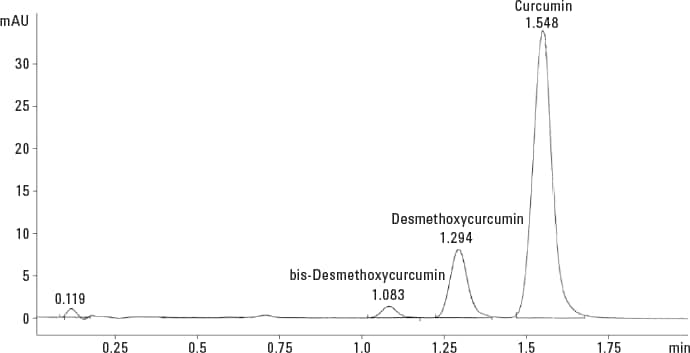
Figure 3. Curcuminoids in turmeric extract using an Agilent 1290 Infinity LC System with an Agilent ZORBAX Eclipse Plus C18, 4.6 x 50 mm, 1.8 µm column.
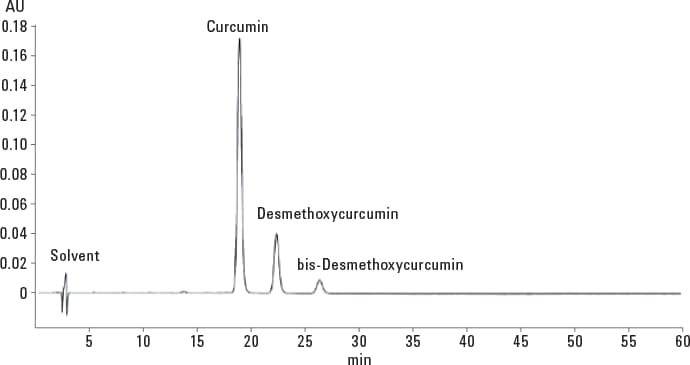
Figure 4. Curcuminoids in turmeric extract using USP method with an Agilent ZORBAX Eclipse Plus C18 4.6 x 250 mm, 5.0 µm column.
Rapid analysis of curcuminoids in turmeric with Agilent 1290 and STM column
Another lab was able to achieve quicker analysis of curcuminoids in turmeric by utilizing a combination of an Agilent 1290 Infinity LC system and a sub-2 µm (STM) column[3]. This method was proven to provide a significant reduction in cycle times with good resolution versus their traditional USP.
Separation and quantification of curcuminoids has been possible with liquid chromatography for some time. However, recent advancements in this technology have drastically increased its efficiency. The quantification of curcuminoids can be accomplished 30 times faster than the lab’s current USP method using the Agilent solution.
Figure 3 shows the separation of three curcuminoids with the new method that uses the Agilent 1290 Infinity LC System combined with the sub-2 µm column. Good separation of all compounds was achieved in less than two minutes. Additionally, this method reduced solvent consumption by 95%.
Figure 4 illustrates the considerably slower and less economical results of the USP analysis which took more than 60 minutes.
For more information on this application, please explore Agilent publication 5991-3340EN.
Agilent offers a broad array of LC solutions for busy lab managers
In both herbal analysis applications described above, the respective laboratories experienced significant reductions in sample run times and substantial cost savings in labor and solvent use over the traditional USP methods. It should be noted that these improvements were achieved with no loss in resolution. Learn more about herbal analysis applications in Agilent publication 5991-1971EN.
Reducing the run time for the analysis of herbals and supplements is just one of the many tasks that today’s lab manager must face. Agilent offers a wide array of liquid chromatography solutions, including the Agilent 1290 Infinity LC and a comprehensive collection of columns and supplies that can help make your lab more productive. Explore our literature, videos, e-seminars, and other helpful resources. Then contact your Agilent representative today to find out how our solutions can help to increase the efficiency of your busy lab.
References
- The Global Herbal Supplements and Remedies Market Report: Trends, Drivers and Projections. Global Industry Analysts, Inc., February 2015.
- Severin, N.; Schwabe, J.; Fast Analysis of Terpene Lactones in Ginkgo Biloba Extract Using the Agilent 1290 Infinity LC and Agilent Poroshell 120 SB-C18 2.7 µm Column. Agilent Technologies, Inc., January 23, 2014.
- Horkey, A.; Rapid Analysis of Curcuminoids in Turmeric Extract Using the Agilent 1290 Infinity LC and STM Columns. Agilent Technologies, Inc., November 11, 2013.
Stay informed about the applications that are important to you
Subscribe to Access Agilent
Our free customized
monthly eNewsletter
Article Directory – April 2016
All articles in this issue
 Analyze low-ppm levels of active sulfur compounds with inert sample path on the Agilent 490 Micro GC
Analyze low-ppm levels of active sulfur compounds with inert sample path on the Agilent 490 Micro GC Fast arsenic speciation for food and urine analysis with Agilent LC-ICP-QQQ
Fast arsenic speciation for food and urine analysis with Agilent LC-ICP-QQQ Simplify achiral-chiral analysis of warfarin metabolites using Agilent 2D-LC/MS solutions
Simplify achiral-chiral analysis of warfarin metabolites using Agilent 2D-LC/MS solutions Optimized detection of gaseous sulfur compounds using Agilent J&W DB-Sulfur SCD GC column and Inert Flow Path
Optimized detection of gaseous sulfur compounds using Agilent J&W DB-Sulfur SCD GC column and Inert Flow Path Oil-free laboratory vacuum eliminates oil mess and disposal costs
Oil-free laboratory vacuum eliminates oil mess and disposal costs Eliminate conventional SEC roadblocks with Agilent AdvanceBio SEC columns
Eliminate conventional SEC roadblocks with Agilent AdvanceBio SEC columns Fast, economical assessment of herbals with Agilent 1290 Infinity LC system and LC columns
Fast, economical assessment of herbals with Agilent 1290 Infinity LC system and LC columns Agilent 5977B GC/MSD with HES offers improved VOC detection limits
Agilent 5977B GC/MSD with HES offers improved VOC detection limits
Figure 1

Terpene lactones in ginkgo biloba extract. Agilent 1290 Infinity LC with an Agilent Poroshell 120 SB-C18 2.7 µm column.
Figure 2

Terpene lactones in ginkgo biloba extract. USP method using Phenomenex Luna C-18 250 x 4.6 mm, 5.0 µm column.
Figure 3

Curcuminoids in turmeric extract using an Agilent 1290 Infinity LC System with an Agilent ZORBAX Eclipse Plus C18, 4.6 x 50 mm, 1.8 µm column.
Figure 4

Curcuminoids in turmeric extract using USP method with an Agilent ZORBAX Eclipse Plus C18 4.6 x 250 mm, 5.0 µm column.